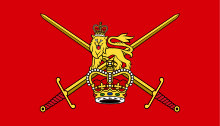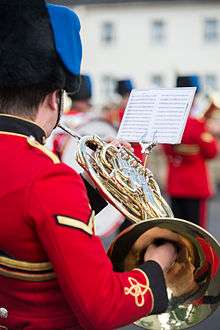Corps of Army Music
The Corps of Army Music (CAMUS) is a Corps of the British Army dedicated to the provision and promotion of military music.
| Corps of Army Music | |
|---|---|
 Cap Badge of the Corps of Army Music | |
| Active | 1994 to Present |
| Country | |
| Branch | |
| Motto(s) | Nulli Secundus (Second to None) |
| March | The Music Makers (quick) Esprit De Corps (slow) |
| Commanders | |
| Colonel in Chief | The Countess of Wessex |
| Colonel Commandant | Colonel Vicky Reid |
 |
| Arms of the British Army |
|---|
| Combat Arms |
|
|
| Combat Support Arms |
|
| Combat Services |
|
|
History
The formation of the Corps of Army Music was triggered by a defence review known as Options for Change in the early 1990s and followed a 1993 announcement by the Chief of the General Staff that the number of army bands was to be reduced from 69 to 30. The period saw the number of personnel from 2,000 to 1,100, with Lieutenant Colonel Roger Tomlinson of the Royal Military School of Music describing it as "a gloomy time for those of us in the military music business".[1] The Queen signed a warrant on 13 August 1994 to allow the formation of the Corps of Army Music. This stated that it was Her will and pleasure that all officers who were Directors of Music in the various Corps and Regiments and that all army musicians should transfer to the Corps of Army Music - now the newest and most junior corps in the army - on 1 September 1994.[2]
The home of the corps was established at Kneller Hall in Twickenham, a site that encompasses the Headquarters of the Corps of Army Music and the Royal Military School of Music. The school was founded by the Duke of Cambridge, soon after his appointment as Commander in Chief in 1857, when the first class of military musicians was formed, a 'Class of Music'. The establishment was retitled as The Royal Military School of Music by Queen Victoria in 1887.[2]
The Future Army Structures review of 2006 saw the bands of the Regular Army reduced from 30 to 23.[3]
The Future of the Corps of Army Music

The Future Army Music 2020 (FAM2020) was published in August 2013. It contained information about how the Corps of Army Music would be restructured and better suited to enable sustainable musical support to be provided to the Army and Defence supporting operations and defence diplomacy.[4]
There will be:[5]
- One 64-piece symphonic wind band supplying marching and traditional music
- The Band of The Household Cavalry
- Six 46-piece symphonic wind bands supplying marching and traditional music
- Band of the Grenadier Guards
- Band of the Coldstream Guards
- Band of the Scots Guards
- Band of the Irish Guards
- Band of the Welsh Guards
- The Band of The Royal Regiment of Scotland
- Two 35-piece wind band supplying marching and traditional music
- Six 35-piece multi capability bands supplying marching and contemporary music
- The Band of the Royal Armoured Corps
- The Royal Artillery Band
- The Band of the Corps of Royal Engineers
- The Band of The Queen's Division
- The Band of The Parachute Regiment
- The Band and Corps of Drums of The Royal Logistic Corps
- Three 32-piece Brass bands supplying marching and traditional music
- The Band of the Royal Corps of Signals
- The Band of The King's Division
- The Band of The Prince of Wales' Division
- One 24-piece String orchestra
- The Countess of Wessex String Orchestra
- Three 15-piece Specialist bands supplying modern pop music
- The Band of the Corps of Royal Electrical and Mechanical Engineers
- The Band of the Adjutant General's Corps
- The Band of the Army Air Corps
These changes will be implemented between 2014 - 2018.
The regiments of the Life Guards and The Blues and Royals will have their bands merged to form a single band of the Household Cavalry.[4]
The five Foot Guards Bands will remain in London, as Symphonic Wind Bands and the Edinburgh-based Band of The Royal Regiment of Scotland will grow to the same strength as the Foot Guards Bands.[4]
The 10 man strong Light Cavalry Band will be amalgamated with the Heavy Cavalry and Cambrai Band to form the Band of the Royal Armoured Corps.[4]
A string orchestra, to be known as the Countess of Wessex's String Orchestra, will be based in Woolwich and manned with 24 personnel.[6]
Military Music Optimization
In 2019, the regular Army band laydown was adjusted to enable several smaller bands to train and perform as larger bands for more significant Army events. Co-locating 11 of the smaller bands in three major garrisons and Sandhurst has increased the flexibility of CAMUS to perform at a huge breadth of events without compromising any of the traditional bands that have been performing for many years.[7]
Bands of the Corps
The bands of the corps are as follows:[8]
- The Band of the Household Cavalry - Hyde Park Barracks, Knightsbridge, London
- The Band of the Grenadier Guards - Wellington Barracks, Westminster, London
- The Band of the Coldstream Guards - Wellington Barracks, Westminster, London
- The Band of the Scots Guards - Wellington Barracks, Westminster, London
- The Band of the Irish Guards - Wellington Barracks, Westminster, London
- The Band of the Welsh Guards - Wellington Barracks, Westminster, London
- The Band of the Royal Regiment of Scotland - Dreghorn Barracks, Edinburgh
- The Band and Bugles of The Brigade of Gurkhas - Shorncliffe Camp, Folkestone
- The Band and Bugles of The Rifles - Sir John Moore Barracks, Winchester
- The Countess of Wessex's String Orchestra - Royal Artillery Barracks, Woolwich, London
- British Army Bands Catterick, incorporating:
- The Band of the Royal Armoured Corps
- The Band of the King's Division
- The Band of the Corps of Royal Electrical and Mechanical Engineers
- British Army Bands Tidworth, incorporating:
- The Royal Artillery Band
- The Band of the Corps of Royal Engineers
- The Band of the Adjutant General's Corps
- British Army Bands Sandhurst, incorporating:
- The Band of the Royal Corps of Signals
- The Band of the Royal Logistic Corps
- British Army Bands Colchester, incorporating:
- The Band of the Queen's Division
- The Band of the Parachute Regiment
- The Band of the Army Air Corps
Army Reserve Bands
Prior to Options for Change and the formation of the Corps of Army Music most regiments, especially in the infantry, maintained their own military bands. This tradition is now continued by the Army Reserve, who retain regimental and corps bands. While the Army Reserve Bands are not part of the Corps of Army Music, their musicians are trained by the Royal Military School of Music. They are still under the direct command of their parent corps or regiment.
There are currently 20 Reserve Military Bands located across the UK and Gibraltar and these are:[9]
- Band of the Honourable Artillery Company
- The Inns of Court and City Yeomanry (Band of the Royal Yeomanry)
- Lancashire Artillery Volunteers Band
- The Nottinghamshire Band of the Royal Engineers
- The (Northern) Band of the Royal Corps of Signals
- Lowland Band of the Royal Regiment of Scotland
- Highland Band of the Royal Regiment of Scotland
- Band of the Princess of Wales's Royal Regiment (Queen's and Royal Hampshires)
- Band of the Royal Regiment of Fusiliers
- Band of the Royal Anglian Regiment
- Volunteer Band of the Royal Gibraltar Regiment
- Band of The Royal Irish Regiment (27th (Inniskilling) 83rd and 87th and Ulster Defence Regiment)
- Band of the Royal Welsh - The only Brass Band in the Army Reserve
- Band of the Duke of Lancaster's Regiment (King's Lancashire and Border)
- Band of the Yorkshire Regiment (14th/15th, 19th & 33rd/76th Foot)
- The Band of The Mercian Regiment
- The Salamanca Band of The Rifles
- The Waterloo Band of The Rifles
- Band of 150 Regiment, Royal Logistic Corps
- Band of the Army Medical Services
Order of Precedence
| Preceded by Queen Alexandra's Royal Army Nursing Corps |
Order of Precedence | Succeeded by Royal Monmouthshire Royal Engineers |
References
- "TRADITION : Stop the Music! British Budget Cuts Out Many Military Bands". Los Angeles Times. May 1, 1993.
- "Corps of Army Music: history". Retrieved 10 May 2014.
- "Army's axe to fall on the marching bands". The Telegraph. 12 December 2004. Retrieved 10 May 2014.
- "Changes to the Corps of Army Music". Ministry of Defence. Retrieved 10 May 2014.
- "Our music - British Army Website". Army.mod.uk. Retrieved 2014-05-10.
- "The Countess of Wessex's String Orchestra - British Army Website". Army.mod.uk. 2014-03-03. Retrieved 2014-05-10.
- "Bands of the Corps". Ministry of Defence. Retrieved 14 Feb 2020.
- "Bands of the Corps". Ministry of Defence. Retrieved 14 Feb 2020.
- "Reserve Bands". Ministry of Defence. Retrieved 10 May 2014.
External links
| Wikimedia Commons has media related to Corps of Army Music. |
- Corps of Army Music - on British Army official website